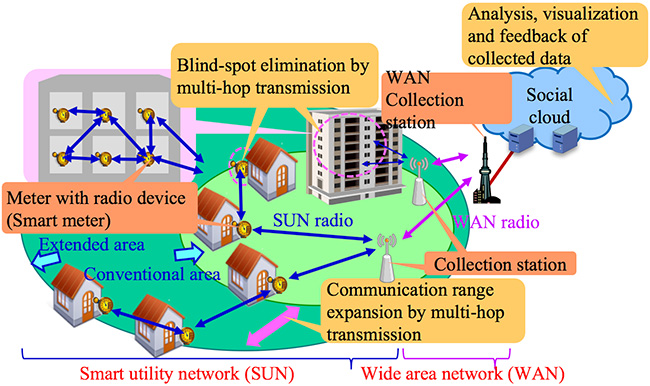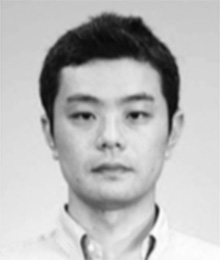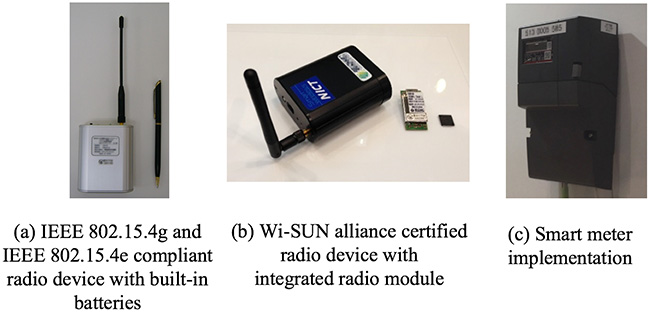Smart metering systems are systems that effectively manage automatic metering, remote cut-off, and accounting by deploying radio communication capable meters for gas or electricity lifeline infrastructures (Fig. 1). From the beginning of the system conception, there were a variety of studies on radio devices for such smart meters that can realize adequate service areas (more than 1km), low-energy operation, interoperability among vendors and global standard compliance. Unfortunately, there were no suitable candidates for such radio devices for a long time, which also resulted in the difficulty of reducing costs reduction for radio function implementation.
The recipients have conducted research and development on the PHY frame structure and low-energy MAC scheme that enable a communication distance of more than 1 km and battery operation for several years to about 10 years, which have been standardized as IEEE 802.15.4g, IEEE 802.15.4e and ANSI/TIA-4957 standards. The recipients have made a lot of contributions. Their proposing frame synchronization sequence that has been standardized as one of the mandatory specifications is also known as one of the worthiest contributions. This frame synchronization sequence has been implemented in all of IEEE 802.15.4g compliant radio ICs in the world. In March 2012, the recipients successfully developed the worldfs first small-sized and low-energy radio device that was compliant to both IEEE 802.15.4g and IEEE 802.15.4e standards (Fig. 2(a)). Moreover, the recipients have contributed to IEEE 802.15.4g and TIA TR-51 standardization management by holding key positions such as vice-chair.
@Furthermore, the recipients established the certification body for radio devices compliant to those standards, namely the Wi-SUN alliance, which finalizes the certification specifications (Wi-SUN profiles) for both conformance and interoperability for standard compliant radio devices firstly in Japan, thereby proactively contributing to the effective promotion of those devices. The Wi-SUN alliance consists of more than 170 organizations all over the world as of January 2018, though it used to consist of only 9 in 2012. As members of the alliance, the recipients launched a working group that finalizes Wi-SUN profiles for the communication links (known as gRoute Bh in the electric power industry) between smart meters and home energy management systems (HEMS), and played a leadership role in finalizing the profile that defines not only PHY and MAC layer specifications but also higher-layers including network authentication. The recipients hold the positions of chair and technical editor in this working group. In January 2014, the recipients successfully developed the world first Wi-SUN alliance certified radio device (Fig. 2(b)).
Additionally, the recipients standardized the Wi-SUN profile certified for electric meters with conformance and interoperability as a domestic standard JJ300.10 in Telecommunication Technology Committee (TTC). According to decisions of the Ministry of Economy, Trade and Industry (METI) and Japan Smart Community Alliance (JSCA) to deploy the Wi-SUN profile in Route B for major electric power companies in Japan, and the profile was adopted in the smart metering systems of Tokyo Electric Power Company that holds 27 million meters in 2013 Oct (Fig. 2(c)). Tokyo Electric Power Company has adopted the IEEE 802.15.4g standard in not only Route B, but also in the communication link among several meters, known as Route A. Then, all major electric power companies in Japan have adopted this Wi-SUN profile based on the IEEE 802.15.4g standard and have finished 20 million installations as of the end of FY 2018, which will be expanded into 80 million installations in the future. Radio communication modules compliant to the Wi-SUN profile and the gateway terminals equipping such modules are already commercialized and commonly available on the market. Finally, these achievements of the recipients have been highly rewarded with awards such as Prizes for Science and Technology, The Commendation for Science and Technology from the Minister of Education, Culture, Sports, Science and Technology (in 2014) and the Minister of Internal Affairs and Communications Awards Connected Innovations Grand Awards under the Industry-Academia-Government Collaboration Contributors Awards Program (in 2014).
To summarize, the recipientsf achievements have significantly contributed to market creation for more than tens of millions of radio devices for smart meter systems, by perfectly conducting research, development, global and domestic standardization, promotion and commercialization. It is therefore confirmed that the recipients deserve this IEICE Achievement Award.
References
- Hiroshi Harada, Keichi Mizutani, Jun Fujiwara, Kentaro Mochizuki, Kentaro Obata, Ryota Okumura,gIEEE 802.15.4g based Wi-SUN Communication SystemsAh IEICE Trans. Commun.,E100-B,3,pp.1032-1043, July 2017.
- Liru Lu, Hiroshi Harada, Ryuhei Funada, Chin Sean Sum, gDesign of the Start-Frame-Delimiter Pair for 802.15 Smart Utility Network Systemh IEICE Trans. Commun.,E96-B,3,pp.730-736, March 2013.
- Fumihide Kojima, Hiroshi Harada,gFeasibility study and proof test on smart meter network employing IEEE 802.15.4g/4e compliant SUN radio devices, RCS 2012-139, October 2012. (in Japanese)
- Fumihide Kojima, Hiroshi Harada,gPerformance evaluation and proof test on low energy superframe structure for IEEE 802.15.4g/4e draft compliant multi-hop SUNAhIEICE Tech. Report, NS 2011-134, December 2011. (In Japanese)
- METI, JSCA Smart House/Building Standardization Business Promotion Study Group, gHEMS-Smart meter Route-B (for low-voltage electricity meter) Operation Guideline.h (In Japanese)

Fig. 1 Overview of smart metering system
Fig. 2 Developed IEEE 802.15.4g and IEEE 802.15.4e based radio devices







